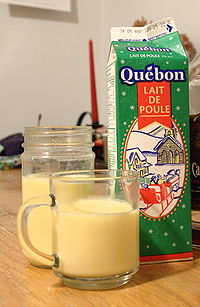Eggnog: Difference between revisions
Black Stripe (talk | contribs) No edit summary |
Adding 'and Canada' to the introduction |
||
| Line 4: | Line 4: | ||
'''Eggnog''' is a sweetened [[dairy]]-based [[beverage]] made with [[milk]], [[cream]], [[sugar]], beaten [[egg (food)|egg]]s (which gives it a frothy texture), and flavoured with ground [[cinnamon]] and [[nutmeg]]; alcoholic versions also exist with the addition of various [[liquor]]s, such as [[brandy]], [[rum]], and [[whiskey]] known as [[Advocaat]]. |
'''Eggnog''' is a sweetened [[dairy]]-based [[beverage]] made with [[milk]], [[cream]], [[sugar]], beaten [[egg (food)|egg]]s (which gives it a frothy texture), and flavoured with ground [[cinnamon]] and [[nutmeg]]; alcoholic versions also exist with the addition of various [[liquor]]s, such as [[brandy]], [[rum]], and [[whiskey]] known as [[Advocaat]]. |
||
Eggnog is a popular drink throughout [[the US]], and is usually associated with winter celebrations such as [[Christmas]] and [[New Year]]. Commercially, non-alcoholic eggnog is available around Christmas time and during the winter. |
Eggnog is a popular drink throughout [[the US]] and [[Canada]], and is usually associated with winter celebrations such as [[Christmas]] and [[New Year]]. Commercially, non-alcoholic eggnog is available around Christmas time and during the winter. |
||
==History== |
==History== |
||
Revision as of 20:51, 22 March 2009

Eggnog is a sweetened dairy-based beverage made with milk, cream, sugar, beaten eggs (which gives it a frothy texture), and flavoured with ground cinnamon and nutmeg; alcoholic versions also exist with the addition of various liquors, such as brandy, rum, and whiskey known as Advocaat.
Eggnog is a popular drink throughout the US and Canada, and is usually associated with winter celebrations such as Christmas and New Year. Commercially, non-alcoholic eggnog is available around Christmas time and during the winter.
History
The origins, etymology, and even the ingredients used to make the original eggnog drink are debated. Eggnog, or a very similar drink, may have originated in East Anglia, England, though it may also have been developed from posset (a medieval European beverage made with hot milk). An article[1] by Nanna Rögnvaldsdóttir, an Icelandic food expert, states that the drink adopted the "nog" part of its name from the word "noggin", a Middle English phrase used to describe a small, wooden, carved mug used to serve alcohol. Another name for this British drink was Egg Flip. Yet another story is that the term derived from the name "egg-and-grog", a common Colonial term used to describe rum. Eventually the term was shortened to "egg'n'grog", then "eggnog".[2]
The ingredients for the drink were too expensive and uncommon for the lower classes, but it was popular among the aristocracy. "You have to remember, the average Londoner rarely saw a glass of milk," says author and historian James Humes (To Humes It May Concern, July 1997). "There was no refrigeration, and the farms belonged to the big estates. Those who could get milk and eggs to make eggnog mixed it with brandy or Madeira or even sherry."[3]
The drink crossed the Atlantic to the English colonies during the 18th century. Since brandy and wine were heavily taxed, rum from the Triangular Trade with the Caribbean was a cost-effective substitute. The inexpensive liquor coupled with plentiful farm and dairy products helped the drink become very popular in America.[4]
Ingredients
Modern eggnog typically consists of milk, sugar and eggs. Frequently cream is substituted for some portion of the milk to make a much richer drink. In some eggnogs you can find gelatin. Toppings may include vanilla ice cream or whipped cream.
Eggnog can be produced from homemade recipes, however ready-made eggnog containing alcohol and "just-add-alcohol" versions are available for purchase. Whiskey, rum, brandy, or cognac are often added. Since the 1960s, eggnog has often been served cold and without alcohol, both of which are significant departures from its historical origins. Lowfat eggnog is commercially available or it may be prepared in the home using skimmed or lowfat milk.[5] In North America, a few soymilk manufacturers, including the widely available brand Silk, offer seasonally-available, soy-based alternatives for vegans and those with dairy or milk allergies. Eggnog may be added as a flavouring to food or drinks such as coffee and tea. Eggnog-flavoured ice cream, for example, is a seasonal product in the US.
| IBA official cocktail | |
|---|---|
| Type | Mixed drink |
| Base spirit | |
| Served | On the rocks: poured over ice |
| Standard garnish | Nutmeg |
| IBA specified ingredients† |
|
| Preparation | Pour all ingredients into shaker with ice cubes, shake well. Strain into a champagne flute with ice cubes. Sprinkle with fresh ground nutmeg. |
| † Brandy Egg Nog recipe at International Bartenders Association | |
Significance
Eggnog is typically served as a Christmas drink or during New Year's Eve in the United States and Canada. American Thanksgiving (late November) falls at the beginning of the season in which eggnog is typically consumed, but the product begins appearing in stores around Halloween and can be found in a small handful of stores year-round. Historically it has been a winter beverage not specifically associated with any holiday.
References
- ^ Rögnvaldsdóttir, Nanna. "History of Eggnog". What's Cooking America. Retrieved 2006-12-16.
{{cite web}}: Unknown parameter|coauthors=ignored (|author=suggested) (help) - ^ http://www.thenibble.com/reviews/main/cocktails/mount-gay-egg-nog.asp
- ^ Robinson, Oliver (2006-12-15). "Bottoms Up: Eggnog". that's Beijing Magazine and Blogs. True Run Media. Retrieved 2006-12-16.
- ^ Block, Stephen. "The History of Egg Nog". Food History. The Kitchen Project. Retrieved 2006-12-16.
- ^ Low Fat Eggnog
- Rombauer, Irma S. and Marion Rombauer Becker (1931 [1964]) The Joy of Cooking, pp 48, 50. Indianapolis: Bobbs-Merrill. ISBN 0-452-25665-8.
See also
- Ponche crema
- Kogel mogel
- Soda sữa hột gà
- Advocaat
- Zabaglione
- Coquito
- Eierpunsch
- Rompope
- Cola de mono
- Tamagozake
External links
- Eggnog on NPR with Alton Brown
- Cyril K. Collins Eggnog Recipe, a 3rd generation (at least!) recipe
